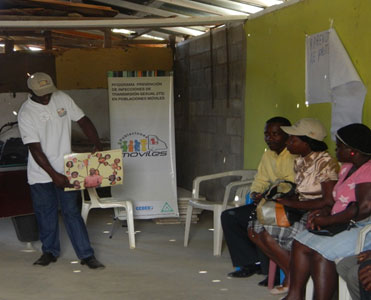People on the Move: Reaching Mobile Workers in the Dominican Republic
With impressive results in the battle against HIV/AIDs in cities and towns, public health officials in the Dominican Republic are now devoting attention and resources to a more scattered and hard-to-find population – so-called mobile workers.

“Promotores” working with mobile populations in Dominican Republic to prevent HIV/AIDS.
These are people who perform seasonal work on farms and the Dominican Republic’s sugar cane plantations. They are also construction workers as well as laborers who come to the Dominican Republic to find work. They are truck drivers and street vendors. They are literally on the move.
The precise size of the population is difficult to calculate but data shows that these workers are both disproportionally affected and, because they often live in rural and isolated areas, are less likely to have access to treatment and education.
That’s why the Dominican Republic’s Ministry of Health, with the help of CDC’s country office and non-governmental agencies, has collaborated to provide services to this population.
One of them is MOSCTHA, which with funding from CDC, recruits and trains farm and construction workers as lay health educators. They form the core of mobile health units that go to farms, construction sites and other places to provide testing and counseling to transient workers.
The “promotores,” who once were farm and construction workers themselves, are especially effective because they are from the local community and often are familiar faces. They have intimate knowledge of the work and the people they serve. That allows them to approach people who might be wary of others. It allows them to offer counseling, testing, and condoms.
While more work needs to be done, the early results are encouraging. Last year, 22,120 people from mobile population were reached through individual and/or in small group interventions. In all, 7,388 people were tested last year.

CDC funds MOSCTHA a partner in the Dominican Republic that recruits and trains the farm and construction workers that serve as lay health educators.
Through training the health care workers and “promotores” the program supports people living with HIV and has additional benefits by raising awareness about HIV/AIDs and the effectiveness of prevention methods. All of that contributes to the larger effort to reduce HIV/AIDs in the country. Perhaps most importantly, they also work to remove the social stigma of the disease.
The focus on mobile populations is part of CDC’s programs developed in partnership with the Dominican Republic’s Ministry of Health. Two of the highest priorities for the Dominican Republic are eliminating the transmission of HIV from pregnant mothers to babies and preventing new cases of adult HIV among high-risk populations.
One of the ways that CDC has worked to address these priorities has been to work with the Ministry of Health to develop a national surveillance system for HIV, tuberculosis, and sexually transmitted infections. In the general population the prevalence of HIV is .8%; approximately 44,000 live with HIV in the Dominican Republic. CDC has also assisted the Ministry of Health with other health emergencies such as cholera.